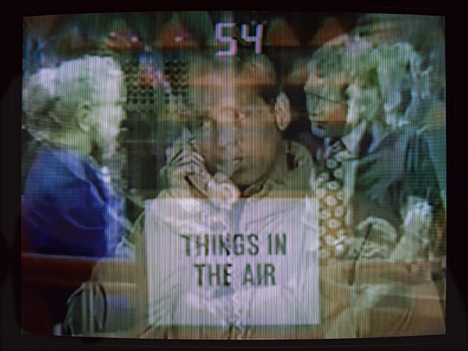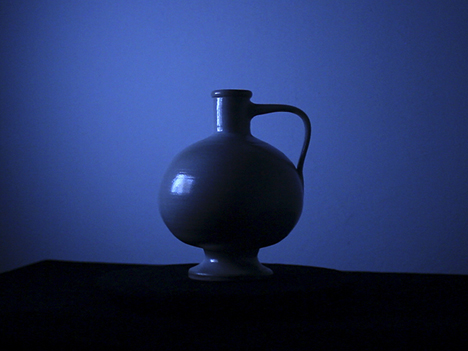Marquee Moon
In 1969, some 600 million viewers around the world watched the first manned moon landing on television. But game shows, talk shows and reality TV became the enduring TV forms. Judy Radul takes another look at domestic scenes bathed in television’s lunar glow.
“This” is television. The indexical “this” mimics the lines of the raster on the television screen that keep scanning down to form the image, which keep announcing the image as present and yet fading, needing to be made present again, and again.

Still from the film. Photo: Judy Radul.
By saying “television” I mean, more or less, that we should talk about the moon. New technologies often bear descriptors that refer to earlier technologies, Marshal McLuhan referred to this as the “horseless carriage” syndrome. We are, for instance, on our second go-round with the term “wireless”. In the 1930s motion picture, newsreels were produced to explain the coming phenomenon of television. Our technological ontologies are unstable – things now regularly shift their form. Before the 1930s and the short-lived spread of television, what people across the Earth watched together was the moon. Around the globe, every night, we see, more or less, the same moon. In 1969 some 600 million people around the world apparently watched the first manned moon landing on television.
Television is seeing at a distance. The television camera may use telephoto lenses to see what is remote, and the television transmitter sends the signal across a distance. The 1960s lunar landings produced the iconic first images of Earth seen from space. This extraterrestrial perspective is what Hannah Arendt called an Archimedian view, a distanced, technologized, objective-seeming, astrophysical worldview that begins with the telescope. For her this represented a move from a shared world to one in which perceptions are no longer direct sensations but rather filtered through technological instruments. For Arendt (she wrote “The Conquest of Space and the Stature of Man” in 1963) the space age emphasizes “process” and abandons the questions of meaning and being, trading the “why” and “what”, for the “how”. “In the place of the concept of Being we now find the concept of Process. And whereas it is in the nature of Being to appear and thus disclose itself, it is in the nature of Process to remain invisible, to be something whose existence can only be inferred from the presence of certain phenomena.”1
As postmodernism emerged, process became a good in its own right. But for Arendt, the openness of process was mitigated by an ethos of the “experimental” which assumes a scientific way of approaching the world. Simulating natural conditions in a laboratory environment leads to a state where we don’t trust our experience of reality, but rather only that which is repeatable (reruns) in experiment. Further, our experiments exceed us and initiate processes “of no return” beyond our conceptualization or control. It is not surprising then that, according to Marshall McLuhan, television also demonstrates this modern bias toward process, “because the low definition of TV insures a high degree of audience involvement, the most effective programs are those that present situations which consist of some process to be completed.”2 His conjectures have been confirmed by the fact that game shows, talk shows and the social experiments of reality TV are the enduring indigenous TV forms.
Hannah Arendt writes of experiments, that we eventually learned how to “repeat the process that goes on in the sun.” Much more equivocal than the atomic mimicry of the sun is the lunar glow of television light. This light bathes the domestic scene with an otherworldly liquid illumination. It passes through the TV screen, which Paul Virilio called the “third window.” It seems to me that Walter Benjamin, who anticipated the shock effect of cinema and the impact of techniques of reproduction on perception and politics, could have been writing about television when he spoke of the moon. One of the first major live broadcasts was the Third Reich’s 1936 Summer Olympics. Benjamin is writing in the 1930s, recalling Berlin while in exile in Paris. He writes of a light that enters through the window of his childhood bedroom and makes everything unfamiliar, a light that creates a world that disturbs his being, not because it is unfamiliar, but rather, through temporal disjunction, this emanation creates a space which feels “wholly occupied by what once had been.” In this section entitled “The Moon” Benjamin writes,
The light streaming down from the moon has no part in the theatre of our daily existence. The terrain so deceptively illuminated by it seems to belong to some counter-earth or alternate earth. […] The pale beam that stole into my room through the blinds gave me to understand this. The course of my sleep was disturbed; the moon cut through it with its coming and going. When it was there in the room and I awoke, I was effectively unhoused, for my room seemed willing to accommodate no one besides the moon. The first things that attracted my gaze were the two cream-coloured basins on the washstand. By day, it never entered my head to dwell on them. […] As happy as I was to receive from my nocturnal surrounds a sign of life – be it only the echo of my own – it was nonetheless an unreliable sign, and was waiting, like a false friend, to dupe me. The deception took place when I had lifted the carafe with my hand to pour some water into a glass. The gurgling of the water, the noise with which I put down first the carafe and then the glass – it all struck my ear as repetition. For every spot on this alternate earth to which I was transported appeared wholly occupied by what once had been. I had no choice but to give myself up to it. When I returned to my bed a moment later, it was invariably with the fear of finding myself already stretched out upon it.3
I’m not really sure what television was. It started small and ended big. Like many technologies it was a collection of parts, a way of viewing and a habit, as much as a being. Television seems to be a point of reception inside me but also an external point of transmission very far away, perhaps bouncing from a satellite in space. I must be made by television. I’m relatively certain of that. However I can’t honestly say I am “close” to the shows I came home to daily: Gilligan’s Island, Barney Miller, All in the Family or Chico and the Man. They form an inside that is distant. Like Benjamin’s moon, television has a place interior but not close.
More highlights from the exhibition

Still from the film. Photo: Judy Radul.

Still from the film. Photo: Judy Radul.
Hannah Arendt, The Human Condition, Chicago Press, 1958
Marshall McLuhan, Understanding Media: The Extensions of Man, McGraw-Hill, 1964
Walter Benjamin, Berlin Childhood around 1900, "The Moon"
Published 23 April 2014
Original in English
First published by Glänta 4/2013
Contributed by Glänta © Judy Radul / Glänta / Eurozine
PDF/PRINTNewsletter
Subscribe to know what’s worth thinking about.



